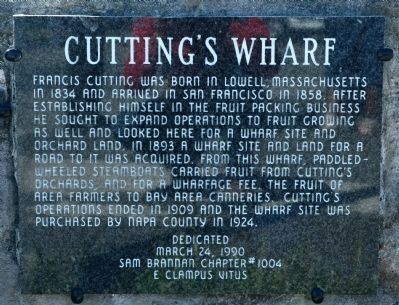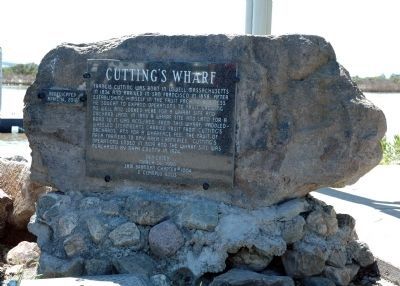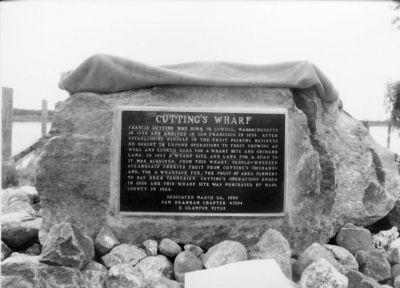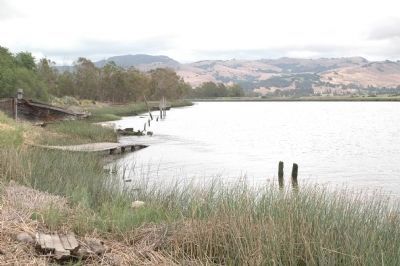Napa in Napa County, California — The American West (Pacific Coastal)
Cutting's Wharf
Erected 1990 by Sam Brannan Chapter #1004 E Clampus Vitus. Replaced and Re-dedicated April 14, 2012.
Topics and series. This historical marker is listed in these topic lists: Agriculture • Industry & Commerce. In addition, it is included in the E Clampus Vitus series list. A significant historical year for this entry is 1834.
Location. 38° 13.563′ N, 122° 18.476′ W. Marker is in Napa, California, in Napa County. Marker can be reached from Cuttings Wharf Road. The marker is located near the public boat launch. Touch for map. Marker is in this post office area: Napa CA 94559, United States of America. Touch for directions.
Other nearby markers. At least 8 other markers are within 5 miles of this marker, measured as the crow flies. Soscol House - 1855 (approx. 2.3 miles away); Napa State Hospital (approx. 4.2 miles away); Holden Mansion 1886 (approx. 4.6 miles away); Embarcadero de Napa (approx. 5 miles away); "Barrel of Fun" (approx. 5 miles away); Napa: A River Landing Town (approx. 5 miles away); Banner Warehouse 1862 (approx. 5 miles away); First Presbyterian Church Building (approx. 5 miles away). Touch for a list and map of all markers in Napa.
Additional commentary.
1. Cuttings Wharf Marker Dedication
Richard Haub was Noble Grand Humbug when this plaque was first dedicated. Bill Rash Sr. was Noble Grand Humbug when this plaque was replaced and re-dedicated. The original bronze plaque was stolen by ne'er-do-wells and sold to recyclers for beer money. The Chapter replaced it with a granite monument.
Plaque wording by Loren A. Wilson.
— Submitted April 18, 2012, by Loren Wilson of Sebastopol, California.
2. Cuttings Wharf
Francis Cutting has the distinction of having been co-founder of the first glass works in California that succeeded in making moderately satisfactory glass. Born in Lowell, Massachusetts, on August 22, 1834, he arrived in San Francisco in 1858 and purchased an interest in a pickle and vinegar business. Prohibitive freight cost and high breakage involved in securing from the East the half-gallon glass jars used in packing pickles led to building a glass works on Beale Street between Howard and Mission in 1859. Cutting shortly afterward sold his interest in the glass works to his partner, A.D. Baker, and took over entirely the business of pickles and vinegar , soon expanding to that of canning fruits and vegetables. With the packing industry of California fruit steadily increasing, it was logical that the Cutting Fruit Packing Company should extend its operations to fruit growing, acquire Carneros land for orchards, and establish a wharf on the Napa River from which to ship the fruit produced to the bay area for canning.
The Farmers Road and Wharf Co. (Francis Cutting, president, F.P. Cutting, secretary), acquired the wharf site and land for a road to it in 1893. The wharf constructed was a pile-and-plank wharf, solidly built, and large enough to accommodate the paddle-wheel steamboats that regularly plied the Napa River and stopped on signal to take on shipments at the wharf.
In 1897 the Cutting Fruit Packing Co. bought some 470 acres of the Rancho Rincon de los Carneros along its western edge. A promotional pamphlet entitled "Napa County and Banking," issued by the J.H. Goodman and Co. Bank in Napa about 1905 or 1906, describes the Cutting property as including 334 acres of orchard, much of it in trees as yet too young to bear, but the whole estimated to be capable of producing from 1500 to 1700 tons of fruit annually at maturity. The wharf served not only for Cutting’s shipments, but also, on a wharfage fee basis, for shipment, mostly of pears, apples, plums, and silver prunes, by farmers of the area.
In 1909, however, the board of directors of Cutting Packing Co. decided to subdivide and sell its Carneros land. Sales began at once and continued over the next several years until the property was disposed of. Napa County bought the wharf and wharf site in 1924 and now maintains the site as Cuttings Wharf County Park. A heavily built launching ramp and a large black-topped parking area have been provided for the use of visitors to the fishing and boating center the place has become. Nothing remains of the Cutting wharf except a few of the original piles.
Courtesy of Napa County Historical Society's Gleanings, Vol.1, No.2, April 1972
— Submitted April 18, 2012, by Loren Wilson of Sebastopol, California.
Credits. This page was last revised on June 16, 2016. It was originally submitted on April 18, 2012, by Loren Wilson of Sebastopol, California. This page has been viewed 1,193 times since then and 14 times this year. Photos: 1, 2, 3, 4. submitted on April 18, 2012, by Loren Wilson of Sebastopol, California. • Syd Whittle was the editor who published this page.



